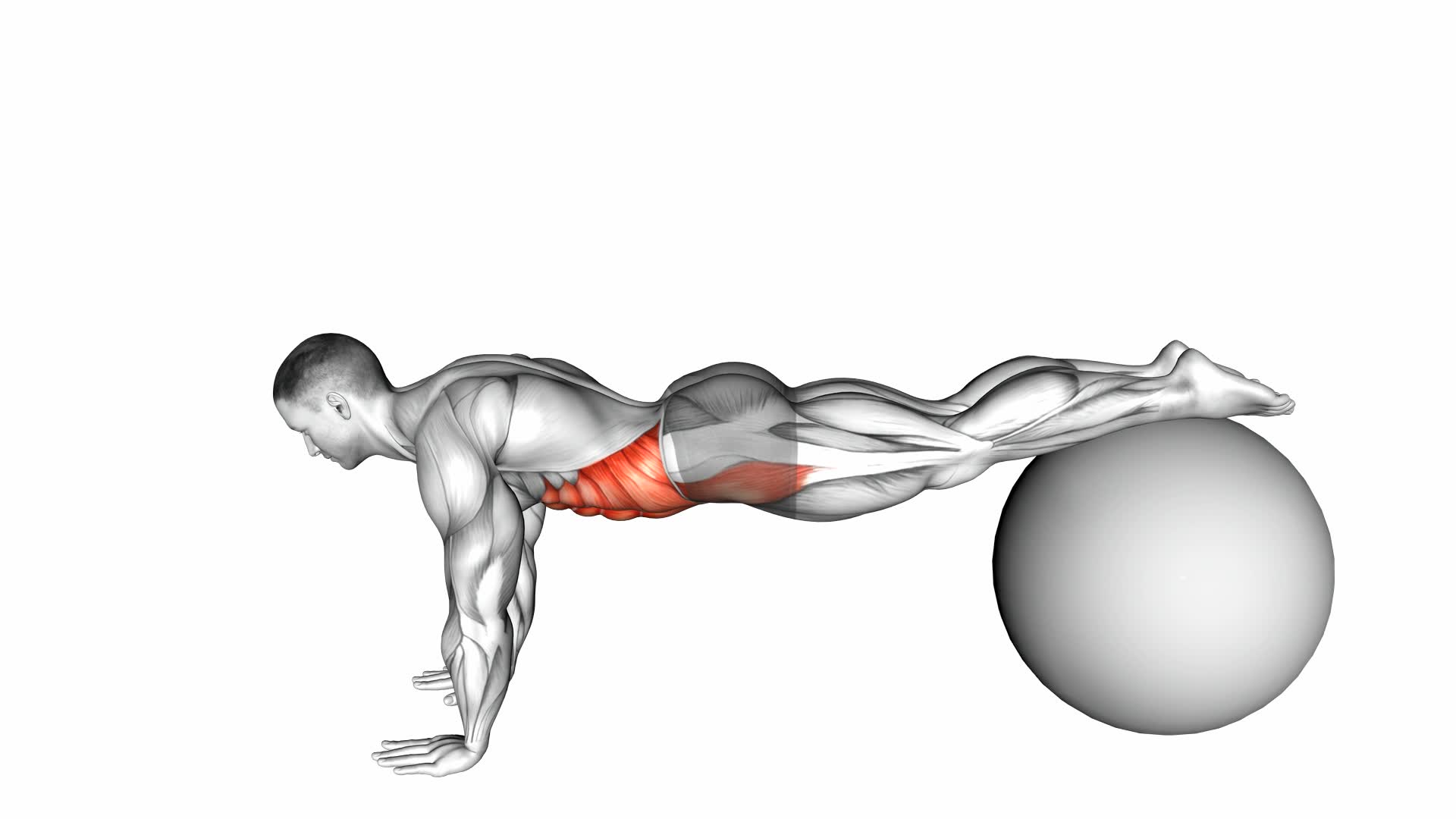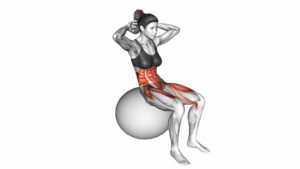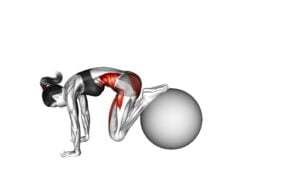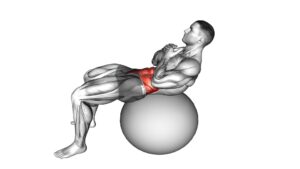Pull-In (On Stability Ball) – Video Exercise Guide & Tips

Get ready to strengthen your core and improve your stability with the Pull-In exercise on a stability ball. In this video exercise guide, you'll learn the proper form and technique for this effective workout.
Watch This Exercise Video
With variations and progressions to challenge yourself, you'll discover new ways to engage your muscles.
Follow our tips for a safe and effective Pull-In workout and start seeing results in no time.
Let's get started!
Key Takeaways
- Pull-in exercise on a stability ball strengthens core muscles.
- It improves balance, stability, and posture.
- Engaging multiple muscle groups enhances overall body strength.
- Variations and progressions can be incorporated to challenge the core muscles.
Benefits of Pull-In Exercise
To maximize the effectiveness of your workout routine, it's important to understand the benefits that the Pull-In exercise can provide.
This exercise is particularly beneficial for strengthening your core muscles. The core is the central part of your body, including your abdominal muscles, lower back muscles, and hips. Having a strong core is essential for stability, balance, and overall body strength.
The Pull-In exercise specifically targets the core muscles, helping to improve their strength and stability. It primarily works the rectus abdominis, the muscle responsible for the six-pack appearance. Additionally, it engages the obliques, which are located on the sides of your abdomen and help with rotational movements. By strengthening these muscles, you can improve your posture, reduce the risk of back pain, and enhance your overall athletic performance.
Performing the Pull-In exercise on a stability ball adds an extra challenge to your workout. The instability of the ball forces your core muscles to work harder to maintain balance and control. This not only enhances core strength but also improves coordination and proprioception.
Incorporating the Pull-In exercise into your workout routine can lead to significant improvements in core strength and overall fitness. It's a versatile exercise that can be modified to suit your fitness level and goals. Remember to focus on proper form and technique to maximize the benefits and reduce the risk of injury.
Equipment Needed for Pull-In Exercise
You will need a stability ball for the Pull-In exercise. Here are some key pieces of equipment and techniques to keep in mind:
- Stability Ball:
- Choose a stability ball that's the right size for your height. When sitting on the ball, your knees should be at a 90-degree angle.
- Ensure that the stability ball is properly inflated and secure. A deflated or unstable ball can lead to injury.
- Place the stability ball on a non-slip surface to prevent it from rolling away during the exercise.
- Exercise Mat:
- To provide cushioning and support, it's recommended to use an exercise mat underneath the stability ball.
- The mat helps to protect your back and provides additional stability during the exercise.
- Proper Technique:
- Position yourself on the stability ball with your stomach facing down, placing your hands on the floor in front of the ball.
- Engage your core muscles and slowly roll the ball towards your chest by bending your knees and pulling them towards your upper body.
- Pause briefly at the top of the movement, then slowly extend your legs back to the starting position while maintaining control.
Proper Form and Technique for Pull-In Exercise
Maintain proper form and technique for the Pull-In exercise by focusing on engaging your core muscles and controlling the movement of the stability ball.
To perform the exercise correctly, start by lying face down on the stability ball with your hands on the ground in front of you. Walk your hands forward until the ball is under your shins and your body is in a straight line.
From this position, engage your core muscles by drawing your belly button towards your spine. Slowly pull your knees towards your chest, using your core muscles to control the movement. Pause briefly at the top of the movement, then slowly return to the starting position.
To ensure proper form and technique, it's important to avoid common mistakes. One common mistake is using momentum to pull your knees towards your chest instead of relying on your core muscles. This can lead to a less effective workout and increase the risk of injury.
Another mistake is allowing your lower back to sag or your hips to lift up, which reduces the engagement of your core muscles.
The Pull-In exercise primarily targets the muscles of your core, including the rectus abdominis, transverse abdominis, and obliques. It also engages the hip flexors and the muscles of your lower back.
Variations and Progressions of Pull-In Exercise
One way to progress the Pull-In exercise is by incorporating different variations that challenge your core muscles in new ways. Here are some advanced progressions you can try to take your Pull-In workout to the next level:
- Single-Leg Pull-In: Perform the Pull-In exercise with one leg lifted off the stability ball. This variation increases the stability challenge and targets each side of your core individually.
- Weighted Pull-In: Hold a dumbbell or medicine ball in your hands while performing the Pull-In exercise. The added resistance increases the intensity and strengthens your core muscles even more.
- Decline Pull-In: Position your feet on an elevated surface, such as a bench, while performing the Pull-In exercise. This variation increases the difficulty by placing your body at a decline, engaging your core muscles in a different way.
By incorporating these different variations into your Pull-In workout, you can keep challenging your core muscles and continue making progress.
Now, let's move on to the next section where we'll discuss some tips for a safe and effective pull-in workout.
Tips for a Safe and Effective Pull-In Workout
To ensure a safe and effective Pull-In workout, focus on maintaining proper form throughout the exercise. Proper form is crucial to prevent injuries and maximize the benefits of this exercise. Here are some tips to help you perform Pull-Ins correctly:
- Start with the basics: If you're new to Pull-Ins, begin with a modified version. Instead of fully extending your legs, keep your knees bent and feet flat on the ground. This will help you build core strength and stability before progressing to the full exercise.
- Engage your core: Throughout the exercise, make sure to engage your core muscles. This will help stabilize your body and prevent excessive strain on your lower back.
- Avoid common mistakes: One common mistake is using momentum to complete the exercise. Instead, focus on controlled movements and use your core muscles to pull your knees towards your chest.
- Maintain proper breathing: Breathe out as you pull your knees towards your chest and inhale as you return to the starting position. This will help you maintain a steady rhythm and engage your core effectively.
Frequently Asked Questions
How Many Calories Can You Burn With a Pull-In Exercise?
To answer your question about burning calories with a pull-in exercise, it's important to understand that the number of calories burned depends on various factors such as your weight, intensity, and duration of the exercise.
Pull-in exercises, when performed on a stability ball, can be a great way to engage multiple muscle groups and increase your heart rate. This can contribute to weight loss and calorie burning.
Remember to maintain proper form and gradually increase the intensity to maximize results.
Can Pull-Ins Help With Improving Posture?
Pull-ins on a stability ball can be beneficial for improving posture. By engaging your core and stabilizer muscles, pull-ins can help strengthen the muscles needed to maintain proper alignment. This can lead to improved posture and reduced risk of back pain.
Additionally, pull-ins require flexibility and mobility in the hip and shoulder joints, which can contribute to overall flexibility and prevent muscle imbalances. Incorporating pull-ins into your exercise routine can be a great way to promote good posture and prevent back pain.
Is It Safe to Do Pull-Ins if You Have Lower Back Pain?
If you're experiencing lower back pain, it's important to prioritize your safety.
While pull-ins can be effective for improving posture, they may not be the best choice if you have lower back pain.
Instead, consider alternative exercises that focus on lower back pain management and strengthening the core without putting excessive strain on your back.
It's always a good idea to consult with a healthcare professional or a qualified fitness trainer for personalized recommendations.
Can Pull-Ins Help in Strengthening the Core Muscles?
Pull-ins are a great exercise for strengthening your core muscles. They engage multiple muscle groups, including your abs, obliques, and lower back. Unlike planks, pull-ins also target your hip flexors and glutes.
If you're looking for alternatives to pull-ins, you can try exercises like mountain climbers, knee tucks, or Russian twists. These exercises provide similar benefits and can help you achieve a strong and stable core.
How Often Should Pull-Ins Be Performed for Optimal Results?
For optimal results, it's important to perform pull-ins regularly.
Pull-ins can be done in various variations, targeting different muscles in the core.
By incorporating this exercise into your routine, you can maximize the benefits of pull-ins, such as strengthening your core muscles and improving stability.
To achieve the best results, aim to perform pull-ins at least three times a week, gradually increasing the intensity and reps as you progress.
Conclusion
In conclusion, the pull-in exercise is a beneficial workout that can be done on a stability ball. It targets the core muscles and improves stability and balance.
To perform this exercise correctly, maintain proper form and technique, and consider using variations and progressions to challenge yourself further.
Remember to prioritize safety and listen to your body throughout the workout for an effective and safe pull-in workout.

Author
Years ago, the spark of my life’s passion ignited in my mind the moment I stepped into the local gym for the first time. The inaugural bead of perspiration, the initial endeavor, the very first surge of endorphins, and a sense of pride that washed over me post-workout marked the beginning of my deep-seated interest in strength sports, fitness, and sports nutrition. This very curiosity blossomed rapidly into a profound fascination, propelling me to earn a Master’s degree in Physical Education from the Academy of Physical Education in Krakow, followed by a Sports Manager diploma from the Jagiellonian University. My journey of growth led me to gain more specialized qualifications, such as being a certified personal trainer with a focus on sports dietetics, a lifeguard, and an instructor for wellness and corrective gymnastics. Theoretical knowledge paired seamlessly with practical experience, reinforcing my belief that the transformation of individuals under my guidance was also a reflection of my personal growth. This belief holds true even today. Each day, I strive to push the boundaries and explore new realms. These realms gently elevate me to greater heights. The unique combination of passion for my field and the continuous quest for growth fuels my drive to break new ground.







